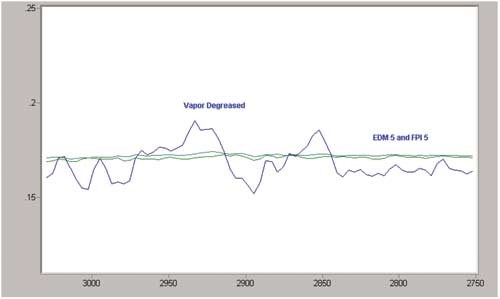Aqueous Cleaning for Aerospace
A turbine manufacturing plant phases out an obsolete vapor degreasing system, making the change to aqueous-based cleaning.
With the use of more exotic materials and more complex geometries, shops producing parts for the aerospace industry often have found themselves struggling to find the right cleaning process that can help meet the corresponding critical standards. So when a company has a cleaning system in place that works, it can be painful to make a change. But that change isn’t necessarily by choice. New environmental regulations often force the hand of a company that then must find a suitable substitute for proven technology.
In the following example, regulatory requirements were the catalyst for change, but the need for better cleaning, improved production and reduced cost should also be considerations for a review of existing cleaning methods at any shop.
Replacing the Old
A manufacturer of turbine and jet engine blades and vanes was being forced by local regulations to replace a vapor degreaser that had been providing the necessary cleaning results. The company contacted Magnus Equipment to help determine a suitable solution for dealing with soils that included EDM oils, machining oils and non-destructive testing (NDT) dye penetrant oils. Because any residual moisture would be detrimental to secondary operations, parts needed to be 100-percent dry.
The existing vapor degreaser was effective and simple to operate, but it required a dedicated operator on every shift to keep up with the cleaning demands. So the sheer number of parts was also a major factor when specifying the proper aqueous cleaning equipment.
The first plan of action was to determine the best method of aqueous cleaning and the best cleaning chemistry. The company determined that immersion agitation would be most effective for the variety of parts, given the complex part configurations and the internal cavities that needed to be addressed. Magnus then worked closely with an aerospace-approved chemical supplier to develop the optimum process times, recommended chemistry and chemical concentration.
The shop then sent some parts to Magnus to run through 85 individual cleaning tests in its full-scale production-sized cleaning equipment laboratory.
Fourier transform infrared (FTIR) analyses were per-
formed on the full spectrum of parts with the complete range of soils. Some soils (particularly the dye penetrant oils) were most effectively cleaned from the small crevices with a combination of immersion agitation and ultrasonics. Ultrasonics also aided in the rinsing for these parts and these soils.
The submitted parts were washed in a 10-mL volume of tetrahydrofuran (THF, inhibitor-free solvent). A 50-µL aliquot of the extract was then placed on a zinc selenide attenuated total reflectance (ATR) cell, and the solvent was allowed to evaporate and was then analyzed by FTIR. The soil from a dirty part was used as a reference sample (28 mg in 20 mL of THF). Quantification of the residue cast on the ATR cell was done by comparing the intensity of the carbon-hydrogen stretching frequencies in the 2,800 to 3,050 cm-1 region of the mid-IR. The peak height absorbance of each cleaned part was ratioed to the calculated number of micrograms of soil per part.
After the cleaning process and parameters were determined and the equipment specified, Magnus proceeded with drying tests. Some parts had the potential to accumulate and pool the cleaner and rinse water. For this reason, drying time would be significantly longer than wet processing time. To avoid a bottleneck in part flow, a multi-stage, variable-speed belt dryer was proposed. With an average washing and rinsing cycle time of 5 minutes, a four-stage dryer would provide 20 minutes of drying while a load would still exit the dryer every 5 minutes, keeping up with the production cycle. The system included a number of features to reduce rinse water usage and chemical consumption and to ensure rinse water purity.
Valuing the New
The resulting cleaning line can run for as long as 6 months without changing the cleaning solution. The rinse water purity in the final rinse is maintained below 20 microsiemens, only requiring make-up water from dragout and evaporation. One operator can process the same number of parts in 3 hours versus the 8 hours that were required with the vapor degreaser. The system has been in full production since 2002 with zero part rejection, and because of its success, the customer has since purchased a second system for another plant location.
Related Content
How Small Machine Shops Can Fight Supply Chain Problems
Supply chain disruptions are still presenting challenges in manufacturing. This article examines the effects on aerospace, automotive and medical industries. It also covers ways that machine shops can be successful securing work despite the challenges created by the supply chain.
Read MoreT.J. Davies Retention Knobs Harden Over Time
Each retention knob is magnetic particle tested and pull tested to 2.5X the pulling force of the drawbar it is designed for.
Read MoreSandvik Coromant Inserts Provide Stable Turning of Aerospace Components
The new insert grades GC1205 and GC1210 cover a large application area within last-stage machining and intermediate-stage machining when turning aerospace engine components.
Read MoreThe Value of Mass Finishing, Shot Blasting for Aerospace and Medical Applications
The choice between mass finishing and shot blasting for CNC-machined parts depends on the specific requirements of the application.
Read MoreRead Next
A Tooling Workshop Worth a Visit
Marubeni Citizen-Cincom’s tooling and accessory workshop offers a chance to learn more about ancillary devices that can boost machining efficiency and capability.
Read More5 Aspects of PMTS I Appreciate
The three-day edition of the 2025 Precision Machining Technology Show kicks off at the start of April. I’ll be there, and here are some reasons why.
Read MoreDo You Have Single Points of Failure?
Plans need to be in place before a catastrophic event occurs.
Read More


























